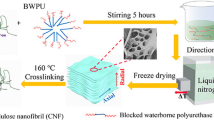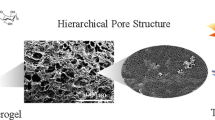Abstract
The traditional polyvinyl alcohol (PVA) gel has low mechanical properties and poor stability, which greatly limits its application in the fields of bioengineering and packaging engineering. Polyethylene glycol (PEG) has been used as porogen and the cellulose nanofiber (CNF)/PVA porous composite gel were prepared by freezing thawing in this study. The changes in physicochemical properties, microstructure and swelling properties of composite gels with different formulations were studied. The results indicated that the CNFs-PEG/PVA gel had a uniform inter-perforated hole structure and good mechanical properties with PEG incorporated. When the mass ratio of CNFs:PVA was 1:10, the average pore size of the formed composite gel was the smallest and the porosity was the largest, and its performance in all aspects was the most excellent. At the same time, the swelling degree can reach 1010, which was greatly improved compared with pure PVA hydrogel. The porous aerogel with high swelling and good mechanical properties prepared in this paper has great potential in the fields of heat and sound insulation and adsorption.
Access this chapter
Tax calculation will be finalised at checkout
Purchases are for personal use only
Similar content being viewed by others
References
Zhu WK, Zhang Y, Xu H (2020) Research progress on preparation and adsorption properties of nanocellulose-based aerogels. Prog Chin Mater 39(04):304–314
Sun GW (2012) Preparation and properties of nanocellulose/polyvinyl alcohol composite gel. Nanjing Forestry University
Wang SX (2019) Preparation of nanocellulose aerogel and its thermal insulation properties. Donghua University
Deng QY (2015) Preparation and properties of biomass nanofibers and polyvinyl alcohol composites. Nanjing Forestry University
Zhang MD, Jin GJ, Huang M (2010) Research progress of nanocomposite hydrogels. Polym Bull 06:41–46
Han JQ, Wang HX, Yue YY (2017) Cellulose nanofibrils-carbon nanotubes/polyvinyl alcohol-borate composite conductive hydrogel. J Compos 34(10):2312–2320
Lu S, Cheng SL (2020) Preparation of cross-linked NFC/PVA hydrogel and its adsorption of heavy metals. J Shanxi Univ (Nat Sci Ed) 43(02):377–384
Liu SJ, Zhou DL, Liu DP et al (2013) Preparation and properties of PVA/chitosan porous hydrogels. J Liaoning Med Coll 34(02):71–74+103–104
Cy X, Jy L, Xmi S (2017) Preparation and properties of polyethylene glycol modified nanocellulose/polyvinyl alcohol composite hydrogel. J Compos 34(04):480–485
Xu CY, Jiang XD, Zhou H (2018) Preparation of magnetic hydrophobic polyvinyl alcohol(PVA)–cellulose nanofiber (CNF) aerogels as effective oil absorbents. Cellulose. https://doi.org/10.1007/s10570-017-1619-9,1217-1227
Sui JP (2017) Preparation and properties of PVA porous hydrogels. Dalian University of Technology
Li JY, Xu CY, Zhou H (2016) Preparation and performance of porous PVA/CNFs composite hydrogel. Pack Eng 37(15):56–60
Xu CY, Li JY, Jiang XD (2017) Preparation and properties of MWCNTs reinforced polyethylene glycol-polyvinyl alcohol composite hydrogel. J Compos 34(06):1191–1198
Han SJ (2016) Study on the formation mechanism and properties of bamboo cellulose aerogel. Zhejiang Agriculture and Forestry University
Xu CY, Li JY, Zhou H (2016) Morphological and swelling behavior of cellulose nanofifiber (CNF)/poly(vinyl alcohol) (PVA) hydrogels: poly(ethylene glycol) (PEG) as porogen. RSC Adv 6(49):43626–43633
Acknowledgements
This research is supported by Zhongshan Major Science and Technology Project (No. 2018A10019).
Author information
Authors and Affiliations
Corresponding author
Editor information
Editors and Affiliations
Rights and permissions
Copyright information
© 2021 The Author(s), under exclusive license to Springer Nature Singapore Pte Ltd.
About this paper
Cite this paper
Sun, X., Zhu, H., You, B., Tan, K., Cao, H., Chen, T. (2021). Preparation and Properties of Polyethylene Glycol Modified Nanocellulose/Polyvinyl Alcohol Composite Gel. In: Zhao, P., Ye, Z., Xu, M., Yang, L., Zhang, L., Zhu, R. (eds) Advances in Graphic Communication, Printing and Packaging Technology and Materials. Lecture Notes in Electrical Engineering, vol 754. Springer, Singapore. https://doi.org/10.1007/978-981-16-0503-1_114
Download citation
DOI: https://doi.org/10.1007/978-981-16-0503-1_114
Published:
Publisher Name: Springer, Singapore
Print ISBN: 978-981-16-0502-4
Online ISBN: 978-981-16-0503-1
eBook Packages: EngineeringEngineering (R0)




